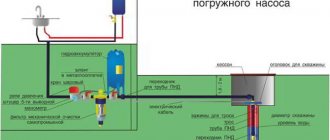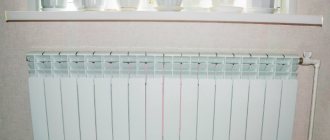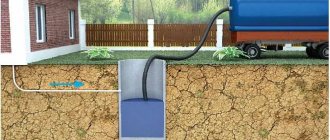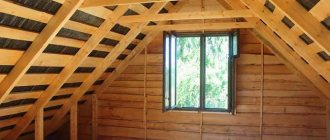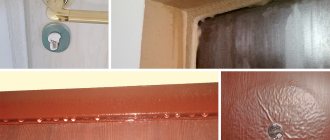Interior mirror, 90 cm x 40 cm
1993 ₽ More details
Hose "Meteor", reinforced, 3-layer (3/4, 25m)
860 ₽ More details
Gray curtains for the living room
Plumbing in a basement is just as important as the foundation, walls, or heating. Many owners organize baths, toilets and other rooms with running water in the basements. In this case, it is necessary to organize the lifting of waste liquids to the level of the main sewer lines.
The relevance of the problem of drainage from basements
The ground level of buildings is increasingly being mastered by the owners of the building. This is due to the need to rationally use all available space. The basement is not always an ideal option for creating a bedroom, living room or children's room there. It is better to use it as a sports room or a second kitchen. In this case, the question arises about creating a bathroom and bathroom.
Sewerage is one of the main elements
Basement drainage is a pressing issue that requires careful planning. The basement floor is below ground level, while all the main sewerage nodes are above. Therefore, it is necessary to provide for effective drainage with raised wastewater. Severely and moderately polluted wastewater must be lifted using special equipment.
Laying a pipe under the base
Electricity can be supplied to the cottage from any location. But sewerage is something else. This will not work here and you will have to resort to serious construction tasks.
Steel or PVC materials are used to supply wastewater. To lay it, you should dig a ditch 2 m deep or less. Then this ditch must be brought under the supports of the house. The parameters of the ditch depend on the depth of soil freezing.
The pipeline itself must be installed under the base. For these purposes, you should punch a hole in the foundation. To ensure that everything turns out as beautifully and accurately as possible, you can use the advantages of a diamond tool. The pipe should be routed through a special casing.
The need to separate the disposal of heavily and moderately polluted wastewater
Before you begin installing pump equipment or other elements of the sewer system on the basement floor, you should find out the ratio of the waste being pumped out. The choice of special settings depends on this.
For example, when installing one toilet, it will be enough to install a sololift - a device with low power required for pumping out fecal waste. It is used for the removal of heavily contaminated waste.
Interesting! As a rule, the ground floor is used to accommodate several sources of water volumes, which means it requires calculation of future water consumption. If the consumed volume of water does not exceed 1 m3, then a sololift will help cope with this task.
In this video you will learn more about sewage systems: Sololift refers to universal pumping stations designed for fecal wastewater. They can be used to remove various types of sewage waste. If the norm is exceeded, it is planned to create two systems. For example, there is a swimming pool in the basement. This means that you need to install a separate pump, which will simply need to pump out water without much contamination.
Ventilation care
To ensure quality ventilation, it is necessary to regularly monitor the operation of the system.
The easiest way is with a lit match. If there is little oxygen and the air contains excess carbon dioxide, it will quickly go out. This is a signal - it's time to start cleaning your air ducts. Dust, debris, cobwebs, ice or frost can accumulate in the gaps of pipes. Sometimes foreign objects are found in the ventilation ducts, and often rodents or other small animals.
To clean, you need to remove valves and electrical appliances from the pipe. Place a container underneath to collect debris and use a thin, strong wire with a brush at the end to move along the entire air path.
In winter, condensation collects in the air ducts. When it freezes, it turns into ice. It is quite difficult to remove the solid mass without damaging the pipe. This is done by heating with hot water or warm air. If traction is restored, the cleaning was successful.
Types of wastewater and options for its disposal
The reliability of the sewer system in the basement of a private house should be high. This involves the use of multiple but suitable pumps. Clogging too much free space with installations is not the best solution. First of all, it is necessary to calculate the possible volume of water that should be pumped out, and only then buy equipment.
The water that forms in the basement can be classified as moderate or severe contamination. Heavy contamination is water in the toilet. Solids that enter the system must be crushed before being discharged into the general sewer system. This will ensure normal throughput.
Cellar ventilation schemes
To ventilate underground rooms, you can use 1 of 3 schemes:
- classic system with one exhaust pipe;
- diagram with two pipes - inflow and exhaust;
- forced air exchange.
Single-pipe ventilation system - fresh air enters the storage through the door.
The choice of option depends on the design of the basement, its location and other conditions. The system with 1 air duct shown in the picture is applicable for cellars with a separate exit to the street. How the scheme works during the cold season:
- The temperature underground is always positive (if the basement is built correctly). Warmer and humid air rises to the upper zone and goes out through the vertical exhaust duct.
- Cold air masses take its place - they seep through the supply openings in the door (hatch), then fall to the cellar floor.
- As the air warms up + humidifies, it begins to lose weight, rises and is thrown out again through the pipe.
Ventilation scheme for a summer kitchen basement with external pipes.
A ventilation system with two pipes is used in cellars without a separate entrance - under private houses, garages and other outbuildings. The natural circulation of air masses is organized in a similar way, only the influx is a second vertical channel, descending to the floor itself. Cold outside air descends through the supply air duct, replacing the gases escaping into the street.
The pipes are located in opposite corners of the storage facility and are removed in two ways:
- in the ground outside the building;
- straight through the roof, as shown in the ventilation diagram of a garage with a cellar and inspection pit.
In the first case, the head of the supply pipe is at the level of the base; it is better to raise the exhaust shaft to a height of 2 m (counting from the intake hole in the basement). If the building is surrounded by other buildings and there is no place to remove the second duct, the air duct is laid in the second way - on the roof. The end of the exhaust pipe rises above the ridge.
Layout of ventilation ducts and air flow in the garage. A transfer pipe cannot be placed between the pit and the cellar
Active air exchange with forced impulse is organized according to a single-pipe or two-pipe scheme, the fan is placed on the exhaust duct. The ventilation operation can be automated by connecting the blower to the power supply via a thermostat. A device with a sensor will turn off the fan when the temperature drops below a preset threshold. Watch the video for details:
Combined disposal of various wastewater
A pumping station is an element that is capable of providing a combined discharge of various wastewater. Several sources of small water consumption that are not polluted can be diverted in this way.
A pumping station can be compared with a sololift, but with greater power and a large storage tank. Some models have a system that prevents reverse current flow. Such a pump is capable of pumping out up to 10 m3 of water per day and providing frequently used sources with a reserve.
The pumping station has one significant drawback - increased noise level. Today there are already models in which this problem has been eliminated. Background noise is reduced at the same power.
Don't forget about the pumping station
Input of water supply: recommendations of a professional
It is very good when the introduction of water supply into a house without a basement is provided for when pouring or assembling the foundation. That is, a special opening is provided for its installation. It is much more difficult to carry out such installation in a finished building, when you have to not only dig the ground, but also make a hole in the concrete or stone layer.
However, both options are possible. We will look at the main indicators that should be followed when laying, installation methods, and also show you a video in this article.
This is what the water supply input to the building should look like:
How to provide backflow protection
The basement, due to its location, requires special attention in terms of creating a sewer system. Pipes that are located at the bottom are most at risk of blockages and contamination. The system is constantly overcrowded.
Reverse flow is a process in which the system overflows and water begins to flow back from the outflow nodes. In this case, you can flood the room with water with an unpleasant odor.
There are effective ways to prevent basement water from backflowing:
- Install equipment that has built-in current resistance. Today there are already many installations that have this possibility. Availability in a specific model must be asked upon purchase.
- Install intermediate backup tanks installed near the house, as well as blocking valves to prevent backflow. The disadvantages of this method include clogging of sewer pipes in the basement.
Disputes among professionals continue to this day. They argue that the likelihood of a drain backflow is so low that it is not worth the cost. Others say it's more important to keep your space safe and sanitary than to think about the money you're spending.
Optimal microclimate in the cellar
To preserve food, it is necessary to create a favorable microclimate in the basement. The humidity level of the room is of great importance.
Equipping a cellar with a ventilation system is undoubtedly important, but it is far from the only condition for maintaining optimal humidity and the required temperature conditions. It is necessary to make a good waterproofing of the basement and periodically carry out a number of measures to drain it
There are several ways to get rid of excess dampness
It is necessary to make a good waterproofing of the basement and periodically carry out a number of measures to drain it. There are several ways to get rid of excess dampness.
With high humidity, you need to ventilate the basement more often. This is especially true in the summer, and if natural ventilation is installed in the cellar.
To get rid of dampness and lower the humidity level in the basement, you must ventilate it by opening the entrance hatchTo dry the basement, you can use simple but quite effective methods. For example, ordinary coarse table salt and quicklime absorb moisture well. They can be brought into the basement and left there for a while.
Another old method that our grandmothers used is to place a lit candle near the exhaust pipe. The flame creates a strong draft in the air duct, thereby accelerating the circulation of air flow.
This method only works in a small cellar, and even in this case it will take several days to dry the room.
To prevent the candle from falling, it must be placed on a flat metal surface.
You can dry the cellar using an electric heater, heat gun or fan, which are installed in the middle of the room. But all these methods are quite expensive, because... will require large amounts of electricity.
Sometimes, on the contrary, it is necessary to increase the humidity in the cellar. In these cases, you can spray water using a spray bottle. A good method is to bring a box of wet sand into the basement or sprinkle the floor with sawdust; they must be periodically sprayed with water.
Features and advantages of operating pumping stations for draining wastewater from basements
The pumping station is a sealed container that plays the role of a mini-storage unit. In this case, wastewater is removed as needed when the container is filled. Pumping stations use special pumps that pump water up into the general sewer system in the basement of an apartment building, or directly into the drain.
The main advantage of the pumping station is the ability to install it in a bathroom or toilet at any stage, and not just during construction. If it is necessary to replace the pumping station, this can be done without difficulty by replacing the new system.
Installations with the following characteristics have advantages:
- Small in size, allowing installation in a bathroom, toilet or other rooms with a small area.
- Providing simple installation and maintenance that does not require calling specialists.
- Having a chopper.
- They have carbon filters that provide the lowest level of odors.
The sewage pumping station is capable of pumping wastewater with high temperatures. Most manufacturers assure that their models do not lose their characteristics, even if the drain temperature reaches 50-55 °C.
The power of the device also plays an important role. To provide for the average family, it is necessary to use a system that can transport wastewater to a height of up to 4 meters and a length of up to 100 meters. The sewage pumping station must have a capacity in the range from 8 to 24 m3/h.
Sewerage in the basement is the optimal solution for hiding pipes
Natural ventilation of the basement in a private house
The least expensive method is to use natural ventilation through vents. At the foundation construction stage, provide paired holes located on opposite walls. According to clause 9 of SNiP 31.01*2003, the total area of vents is at least one four hundredth of the area of the entire basement.
Natural ventilation scheme
Calculate the number and size of each hole. The shape of the vents is not regulated.
- To eliminate “dead zones”, step back 0.9 meters from the internal corners and distribute the air evenly along the entire length of the wall.
- Make similar markings for the opposite wall. If the hole size exceeds 0.3x0.3 meters, reinforce around the perimeter. To prevent the flow of flood waters, please note that the minimum height of the lower part of the vent along the external wall must be at least 0.3 meters from the ground level.
- Cover the holes with rodent mesh.
When pouring a strip foundation, insert cuttings of PVC sewer pipes at equal intervals, tightly closing the holes. After the concrete hardens and the formwork is removed, you will get neat vents.
Note! If the layout of the underground floor includes several isolated rooms, it is necessary to ensure air exchange for each.
If you need to break through vents in a finished foundation, calculate their total size using a similar scheme. To work, you will need a hammer drill or a concrete bit to drill round holes. Remember that violating the integrity of the foundation can weaken its load-bearing capacity, consult a specialist, or choose another method of ventilating the underground space.
Supply and exhaust system
- low cost;
- ease of assembly;
- presence of shaped parts;
- low weight of the structure.
Even a person who does not have construction qualifications can carry out the installation. The work does not require an expensive tool.
Stages of work
The supply and exhaust pipes should be located on opposite walls.
- At a distance of 0.5 meters from the lowest point, secure the pipe and bring it to the surface at a height of 1 meter, thereby ensuring a flow of fresh air.
- Install the exhaust pipe so that its lower part is 1.5 meters above the floor, and the upper part rises above the roof ridge at a height of 0.5 meters.
- Ensure tightness of joints.
- Insulate the air duct.
- Place an umbrella on top of the system to prevent precipitation from entering.
In a properly installed system, temperature differences and pressure differences will create draft.
At the end of the work, check the draft by holding a lit candle to the hood. If the candle flame deviates towards its hole, then the system is working correctly. If the light deviates in the other direction, this indicates the presence of reverse thrust. The problem can be corrected by increasing the height of the exhaust pipe or installing a deflector head.
Forced ventilation of the basement in a private house
If the efficiency of natural air exchange is low, install a duct fan in the exhaust pipe. Installing a second device in the supply pipe will increase the performance of the system. The principle of operation is to pump street air into the underground and more intensively remove exhaust air masses outside.
The power of the devices is calculated by a specialist store consultant based on the size of the room.
Modern duct fans are equipped with a casing and supplied with fasteners, so their installation will not be difficult. Some models are equipped with a timer, which allows you to automate the frequency of turning on the system.
According to sanitary standards, heated living spaces on the ground floor require air conditioning and filtration. Installing a recuperator will allow you to heat the incoming air using the heat removed. Due to the complexity of calculations and the large volume of work, entrust the design and installation of such systems to specialists.
Sololifts
As noted above, sewerage can be organized using sololifts. They are selected according to the same principle as pumping stations. The sololift must have a grinding system. In addition, there is a volume in which wastewater accumulates.
Sololift is the same pumping station, but used for rough waste. At the same time, they are small in size, so the issue of installation is not so relevant. The units have several inlet pipes, so several elements of the system can be connected to it. But Sololift has a small volume, which imposes slight restrictions on pumping capabilities in a certain period of time.
Ventilation issue
Ventilation of basements is carried out, as a rule, using ventilation ducts. Ventilation ducts are made of brickwork with a certain cross-section or from other suitable materials (corrugations, plastic pipes, etc.).
The exhaust pipe is installed under the basement ceiling. Its upper part should extend onto the roof of the house and be located as high as possible. To improve the draft of the basement exhaust pipe, it is necessary to lay it in close proximity to the smoke ducts (for example, the duct of a heating boiler). The upper part of the supply pipe can be placed in the attic, and the lower part - under the basement floor. During the summer months, there is often a lack of natural draft, so many homeowners install a fan in the exhaust pipe.
Laying a pipeline under houses with a buried strip foundation
Before preparing the formwork for the strip foundation, the sleeves must be laid taking into account the following requirements.
For water pipes, the shortest distance between the well/central water supply and the places in the house where water will be supplied (kitchen, bathroom, toilet) should be taken into account. Climatic conditions should be taken into account before laying pipes to depth. It ranges from one meter to three. It is necessary to make an opening in the formwork of a monolithic foundation and pass pipes of the required diameter or lay a sleeve. If the foundation is made of wall blocks, then technological holes should be left in it, which are filled with bricks. The sleeve must be walled up in the masonry.
Pipes through a block foundation Source sdelai-lesnicu.ru
If the groundwater level is less than a meter from the base of the tape, then the joints must be sealed with waterproof solutions and plastic materials. If the soil is wet, then various seals can be used.
When preparing to install a sewer line, the liners need to be laid at a depth less than for a water supply. The degree of freezing and the settling tank influence the placement of the sleeve, which can be laid at 0.7 m or 1.5 m. A waterproof solution or plastic material is suitable for sealing. The use of brown PVC pipes, which are highly durable, is suitable for external drainage circuits.
To increase the maintainability of water supply routes, you can use metal-plastic pipes with a diameter of 25-40 mm. They will run inside low pressure polyethylene pipes (LDPE). If there is a need to replace the internal part, the pipe can be easily pulled out without disassembling the line.
Blockages
Blockages are the number one problem caused by sewer systems, both in terms of quantity and the damage they cause. If there are blockages in the basement, not only the technical basement itself can suffer, but also the apartments on the lower floors.
What is especially unpleasant is that with the sewerage system backed up from below, these apartments begin to flood the drains of all their neighbors along the riser.
A clog in the basement is a disaster for first floor residents
Symptoms
Wastewater begins to flow into the first floor apartment through the toilet, bathtub outlet and leaky siphon connections to the comb. If there are open pipes or revisions in the basement, the drains drown the basement.
It’s curious: residents of lower floors often deliberately open tees and revisions to prevent periodic flooding.
Causes
The author will describe only those causes of blockages that he personally encountered. Here they are:
It’s interesting: fat plugs most often form either in areas with a minimum slope (and, accordingly, a minimum speed of movement of wastewater), or in the coldest sections of pipes (in an outlet laid in the ground to a well).
Solutions
The first step when there is a suspected blockage in the basement is to check the condition of the yard drainage system. To do this, you need to lift the lid of the well closest to the problem area. It can often be found by the inscription on the wall of the house: for example, the mark “KK 8” indicates that the sewer well is located 8 meters from the wall directly opposite the mark.
If the well is filled with waste, the reason is a blockage in the wells located closer to the collector. In this case, the application is transferred to the emergency service of the local Vodokanal.
A full well indicates a clogged yard drain.
If the well is empty, the blockage originated within the house.
The blockage of the riser at the connection to the drainage pipe, the drainage pipe at the connection to the outlet, or the outlet to the well is cleared with steel sewer wire (in the case of a cast iron sewer) - or with a cable (in the case of less durable plastic pipes) through the nearest tee or revision above the blockage.
Tool for cleaning cast iron drains
For plastic pipes it is better to use a softer cable
We emphasize again: higher.
Why is it not worth clearing the blockage through the lower revision?
Because at the moment of destruction of the plug in the riser or drainage pipe, sewage with a pressure of several meters begins to flow to the opened inspection. They have a persistent smell and unique color, cover all objects around with an even layer and do not know pity.
Due to the accumulation of methane in wells, dozens of people die every year
How to clear a clog:
A special case
The biggest problems are caused by bottles and cans that get into the riser through the ventilation outlet onto the roof. They clog the riser at the connection to the bed, and for obvious reasons cannot be cleaned with wire.
Such blockages are broken through... with an ordinary crowbar lowered into the riser from the roof; In this case, it is important not to break through the outlet at the riser connection.
Clearing a clogged drain from a flat roof
Captain Obviousness suggests: in the case of a plastic sewer, it is enough to disassemble the socket connection and shake out the cause of the blockage from the outlet.
Prevention
How to avoid blockages?
Prevention includes only two points:
Please note: to avoid sagging of plastic pipes, they need to be fastened in increments of no more than 10 diameters (for a pipe with a diameter of 110 mm - no more than 1.1 meters).
Sewer leaks in the basement can also occur in addition to blockages - due to a violation of the tightness of the pipes themselves and their connections.
Symptoms
Drains flow onto the basement floor through the flared connection of the bench, through the riser from the ceiling between the basement and the first floor, or through a break in the pipe.
Causes
Solutions
The cast iron socket is hammered with a heel (tow with resin impregnation) or a graphite gland, followed by sealing with cement mortar.
This work is done like this:
The subsidence of the riser in the ceiling is eliminated by lifting it to its original position and fixing the pipe with clamps to the wall. To lift a heavy pipe, overcoming its friction against the ceiling, you will need a lever - a pipe or a crowbar.
If the socket is destroyed, it is easiest to replace it with an assembly of a short (0.3 - 0.5 meter) pipe, a coupling and a compensating pipe with an extended socket.
Compensating pipe with a diameter of 110 mm
Sewer coupling
The replacement is done like this:
The destroyed pipe is replaced with a new one - if necessary, using an assembly of a coupling and a compensating pipe.
Useful: the socket of a plastic pipe fits perfectly onto a cast iron pipe, cleaned of paint, dirt and lubricated with any neutral lubricant.
Small leaks (cracks in the socket or straight section of the pipe, holes punched in the bench or riser) can be eliminated using a bandage made from a bicycle inner tube cut along the circumference or bandage rubber and knitting wire.
Rubber bandage. Ask at pharmacies
The rubber is wound in several turns and tightened with one or two turns of wire.
Rubber bandage on a through fistula of a cast iron riser
Finally, if a socket joint on a plastic bench leaks, the O-ring in it needs to be replaced. If dismantling the connection is difficult, an assembly of a coupling and compensator will again come to the rescue.
In problematic cases, the connection can be sealed with silicone
Prevention
It comes down to monitoring the absence of deforming loads on pipes and sockets. Simply put, the bench pipes must be laid on supports, or suspended at a constant pitch.
Supports and hangers must prevent pipe subsidence
Basement window materials
Windows in the basement are made low, about 20 cm above the ground, so it is quite difficult for them to withstand high humidity. The process of arranging windows in the basement should include the selection of materials that are so moisture-proof that operation is long and problem-free.
Thus, wood in its usual form is definitely not suitable - in hot weather it will shrink, and in cold weather it will swell from moisture and freeze in an expanded form. Structures impregnated with special compounds designed to withstand such loads are required.
Plastic
The PVC profile used to make structures is quite large in size. But it is precisely this design of window openings that is most popular. PVC window structures can increase luminous flux by 15% without loss of thermal properties and rigidity. The use of this material is recommended in the case of a basement that is half underground.
It is necessary that the windows have a ventilation system and shutters that can be opened slightly so that condensation does not accumulate on the walls and other surfaces in the room. Where the opening comes into contact with the wall, additional insulation and protection from water are required; most often, installers use polyurethane foam for these purposes.
Aluminum
Aluminum structures for basements are usually not used, the only exception being an unheated basement with a boiler room or warehouse. Even in the cellar it is necessary to maintain a certain temperature, so aluminum will not work.
If the base is residential and used, then aluminum is not able to provide the necessary protection from the cold. Such structures are much cheaper than plastic, but have better thermal insulation. There are many options for aluminum basement windows to suit every taste and need.
Tree
The base has a high level of humidity, which makes it impossible to use untreated wood for window openings. But more and more often, builders are offering wooden profiles with impregnation, which allows them to successfully resist moisture for many years.
Coating with a special laminate, polymers or compounds gives both the attractiveness of the material and durability without repairs during operation.
Wooden windows are made in different thicknesses; in addition, the material retains heat well and is environmentally friendly, unlike other types of structures. Externally, a wooden profile looks very attractive, especially if the house is built from timber or timber.

